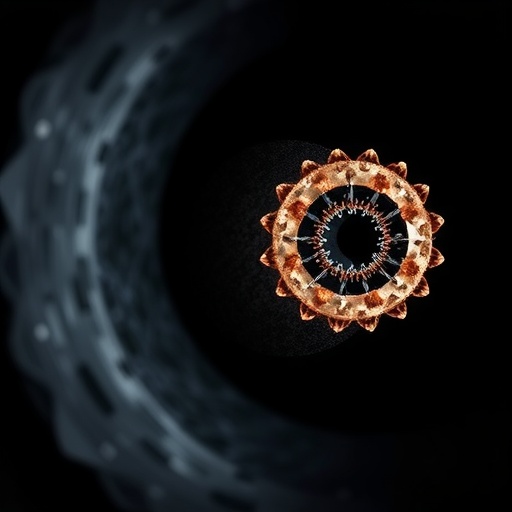In a groundbreaking study published recently in Nature Communications, researchers have unveiled a previously overlooked mechanism responsible for the substantial discrepancy in the absorption enhancement of black carbon aerosols. This revelation challenges longstanding assumptions in atmospheric science regarding how multi-core black carbon particles interact with light, with profound implications for climate modeling and air quality assessments.
Black carbon (BC) aerosols, tiny particles released primarily from incomplete combustion processes, are notorious for their ability to absorb sunlight and contribute to atmospheric warming. Despite extensive research, scientists have struggled to reconcile discrepancies between observed absorption enhancements in ambient measurements and those predicted theoretically. The phenomenon termed “missing absorption enhancement” has bedeviled researchers for years, hindering accurate climate predictions.
The new study, conducted by Chen, Ching, Wu, and collaborators, adopts a multi-disciplinary approach combining microscale imaging, advanced spectroscopy, and rigorous theoretical modeling to pinpoint how multi-core structures within black carbon aerosols influence light absorption. Unlike simpler single-core particles, real-world BC aerosols tend to form aggregates composed of multiple carbonaceous cores, often enveloped by other non-absorbing materials, complicating their optical properties.
Key to this investigation was the discovery that internal electromagnetic interactions between multiple carbon cores within these aggregated particles lead to significant amplification and spatial redistribution of absorbed energy. These interactions alter the conventional understanding of absorption enhancement by introducing intricate near-field coupling effects between adjacent cores, which were previously underappreciated or neglected in conventional climate models.
By employing high-resolution electron microscopy paired with state-of-the-art numerical simulations based on Maxwell’s equations, the team succeeded in mapping the electromagnetic field intensities within realistic multi-core BC aggregates. Their findings revealed “hot spots” of concentrated absorption that dramatically boost total light capture beyond what would be expected from isolated particles, resolving the missing enhancement paradox.
This phenomenon is further amplified when considering the coatings of organic and inorganic matter ubiquitous in atmospheric aerosol mixtures. These coatings can modify the refractive index environment around multi-core BC aggregates, enhancing electromagnetic coupling and consequently absorption. The interplay between particle morphology, composition, and optical interaction emerged as crucial in determining the climate-relevant radiative forcing of BC aerosols.
The implications extend far beyond mere theoretical curiosity. Black carbon’s role as a major contributor to global warming stems from its ability to modulate Earth’s radiative balance. Previous models underestimated the absorption efficiency of multi-core BC aerosols, potentially skewing predictions about aerosol-induced warming, especially in sensitive regions like the Arctic where snow-albedo feedbacks amplify warming effects.
Accurate quantification of absorption by BC particles is essential for climate mitigation strategies, especially those targeting reduction in short-lived climate pollutants. This study provides indispensable insights that pave the way for more reliable parameterizations in global climate models and remote sensing retrieval algorithms, enhancing the precision of atmospheric radiative forcing estimates.
Moreover, the research highlights the urgent need to incorporate detailed micro-physical properties of BC aerosols into policy frameworks. Traditional metrics based on mass concentration or bulk optical properties insufficiently capture the nuanced ways these particles interact with solar radiation, underscoring a methodological shift toward particle-scale characterizations.
The methodological innovations presented also open new avenues for experimental aerosol science. The integration of direct imaging techniques with electromagnetic simulations offers a robust toolkit for probing complex environmental particles, potentially revolutionizing how aerosol optics are studied under realistic atmospheric conditions.
Overall, the elucidation of multi-core black carbon absorption mechanisms marks a significant leap forward in aerosol science. It bridges long-standing gaps between observation and theory, and consequently reshapes our understanding of anthropogenic contributions to atmospheric radiative forcing.
As global leaders grapple with climate crisis mitigation, such scientific advances illuminate the path forward. By better grasping the intricate behavior of aerosols like black carbon, policymakers and researchers can more effectively target source controls and adapt models to forecast future climate trajectories accurately.
Beyond climate, this knowledge may impact public health assessments since black carbon is also a major pollutant linked to respiratory and cardiovascular diseases. Understanding its behavior on a fundamental level will help align environmental health standards with the evolving scientific landscape.
The work by Chen and colleagues exemplifies how detailed physical insights into particulate matter morphology and optical phenomena can cascade into profound societal impacts, from influencing international climate negotiations to shaping day-to-day environmental policies.
In conclusion, by identifying and quantifying the missing absorption enhancement arising from multi-core black carbon aerosols, this landmark study not only solves a long-standing atmospheric science puzzle but also equips the scientific community with critical tools to address climate change with enhanced clarity and precision. It stands as a testament to the power of interdisciplinary research in unveiling nature’s hidden complexities and guiding humanity’s stewardship of the planet.
Subject of Research: The detailed optical absorption mechanisms of multi-core black carbon aerosols and their implications for atmospheric radiative forcing.
Article Title: Locating the missing absorption enhancement due to multi-core black carbon aerosols.
Article References:
Chen, X., Ching, J., Wu, F. et al. Locating the missing absorption enhancement due to multi-core black carbon aerosols. Nat Commun 16, 10187 (2025). https://doi.org/10.1038/s41467-025-65079-2
Image Credits: AI Generated




